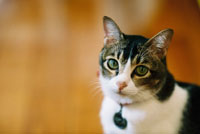Polycystic Kidney Disease (PKD) in Cats
 Polycystic Kidney Disease (PKD) is an inherited disorder of cats in which countless cysts (hence, polycystic) develop in the kidneys.
Polycystic Kidney Disease (PKD) is an inherited disorder of cats in which countless cysts (hence, polycystic) develop in the kidneys.
Polycystic Kidney Disease in Cats
Cysts are small, round, membranous sacs filled with a watery fluid. In feline, PKD, cysts grow and multiply in a cat's kidneys, slowly replacing normal tissue and impairing the organs' function. Kidney failure occurs when the kidneys can no longer keep up with the body’s demands. PKD can also cause cysts in the liver.
What Causes PKD in Cats?
PKD is an autosomal dominant disorder. That means that it is inherited from a single abnormal gene passed from parent to kitten. Generally, 50% of the offspring of an affected cat will have the disease.
PKD is most prevalent in Persian cats and Persian-derived exotic breeds such as Himalayans, British shorthairs, and Scottish folds. A single gene defect called PKD1 has been identified in these breeds. It is estimated that almost 40% of Persian cats carry the PKD1 gene. PKD can also appear sporadically in the general cat population as a random mutation. PKD has many parallels to autosomal dominant polycystic kidney disease, a common congenital kidney disorder in humans.
Signs of Feline PKD
Although the cysts can be found as early as 6 weeks of age, the rate at which the disease progresses varies dramatically from cat to cat. Severely affected kittens may die before 1 year of age. More often, renal failure sets in between the ages of 3 and 10, with age 7 being average. Some cats with PKD live to an advanced age with no signs of kidney failure, and then die of other natural causes.
The signs of PKD in cats, when present, are those of kidney failure and include:
- Lethargy
- Poor appetite
- Vomiting
- Weight loss
- Increased thirst
- Increased urine output
It’s important to note that most PKD cats live silently with the disorder for years, sometimes for a whole lifetime, before signs occur.
Diagnosis of PKD in Cats
PKD may be first suspected when, on a routine exam, your vet notices irregular or lumpy kidneys. This is especially the case for Persians or related breeds. Routine blood work and urinalysis may detect the onset of chronic renal failure. Definitive diagnosis of PKD in cats is made using abdominal ultrasound. Ultrasound is a painless procedure in which a probe emitting inaudible sound waves is applied to the abdomen. The presence of multiple cysts in both kidneys confirms the diagnosis. Ultrasound can also be used for screening at-risk kittens and cats that are not yet showing signs of the disease. Ultrasound diagnosis is 98% accurate for detecting PKD after 10 months of age.
DNA testing for the PKD1 gene is now available and can be used to identify cats that are at risk for developing PKD. The mere presence of the PKD1 mutation is not a predictor of how severely affected an individual will become.
Treatment of Feline PKD
There is no cure for PKD. It is slowly progressive and irreversible. Treatment is indicated once chronic renal failure sets in. As with all cases of chronic renal failure, treatment is aimed at supporting kidney function through nutrition and fluid therapy and by addressing complications such as high blood pressure, electrolyte balance, and anemia as they arise. PKD cats may be good candidates for dialysis or kidney ransplant in areas where these procedures are available.
Prevention of PKD in Cats
Since PKD is hereditary, the best way to prevent it is to identify PKD-affected cats and remove them from the breeding pool by spaying and neutering. Screening is done using ultrasound or genetic testing for PKD1. A cat that is PKD-negative is genetically free of the disease and can be used for breeding. Before purchasing a Persian kitten (or any of the related breeds), ask your breeder if PKD screening has been performed.
You May Also Like These Articles:
Persian Cats: An Interview with Fancy Cat
Subcutaneous Fluid Therapy: Giving Your Cat Fluids at Home
Feline Lower Urinary Tract Disease
Abyssinian Cats: An Interview with Fancy Cat
Top 10 Most Popular Cat Breeds - Slideshow




